The Independent's journalism is supported by our readers. When you purchase through links on our site, we may earn commission.
- Travel
- Europe
- Guernsey
As Matt Ray discovers on a trip to the Channel Islands, Guernsey boasts Caribbean-blue seas, idyllic white-sand beaches and cider orchards, all without the crowds of the English south coast – or St Lucia’s air miles
Saturday 22 November 2025 12:29 GMTComments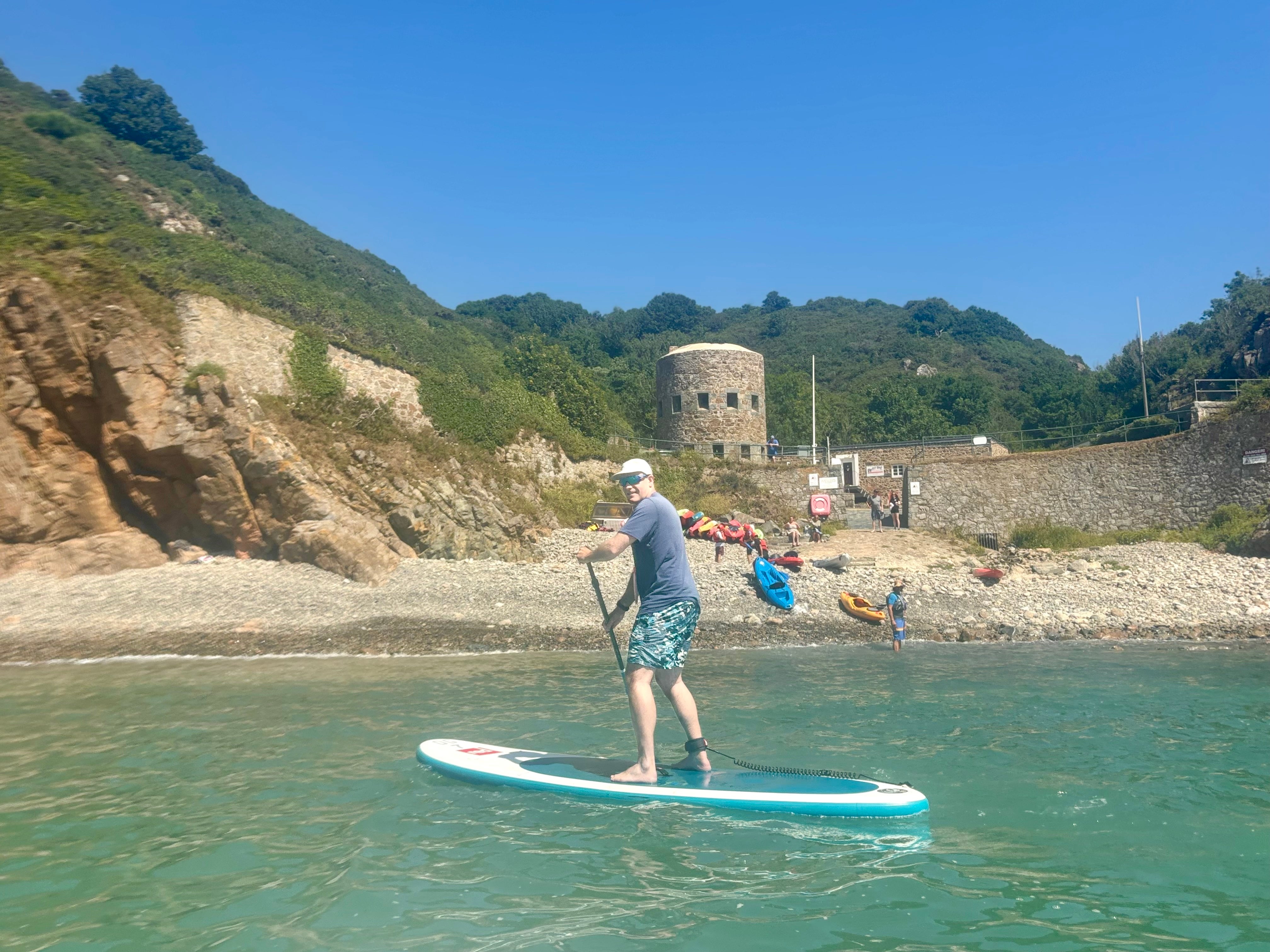 open image in galleryGuernsey has turquoise seas that wouldn't look out of place in Barbados or Bermuda (Matt Ray / The Independent)
open image in galleryGuernsey has turquoise seas that wouldn't look out of place in Barbados or Bermuda (Matt Ray / The Independent)
Sign up to Simon Calder’s free travel email for expert advice and money-saving discounts
Get Simon Calder’s Travel email
Get Simon Calder’s Travel email
 Email*SIGN UP
Email*SIGN UPI would like to be emailed about offers, events and updates from The Independent. Read our Privacy notice
After years of searching out the world’s best beginner surf spots, from Hawaii’s Sunset Beach on Oahu, to Polzeath in Cornwall, I certainly wasn’t expecting to have one of the best surf sessions of my life in the Atlantic waters off the coast of Guernsey.
This self-governing crown dependency wears its Britishness on its sleeve. The street signs and country lanes, studded with pastel-painted homes, certainly look familiar, but if you stand still for a moment and breathe the place in, it suddenly feels very different. The plants, wildlife and scenery have a semi-tropical vibe to them. Even the air feels softer and warmer here, reminding me that while Guernsey is 70 miles from the south coast of England, it’s only 30 miles off Normandy. Despite being just nine miles long and three wide, the island has a host of long sandy beaches, secluded rocky coves and dramatic sea cliffs to explore.
It’s entirely possible to surf the Atlantic swell or sunbathe on the wide-open sands of Vazon Bay on the low-lying west coast, then hop onto an e-bike and traverse the island to the 90m-high craggy cliffs and “Pirate’s cove” of Petit Bot for a paddleboarding adventure.
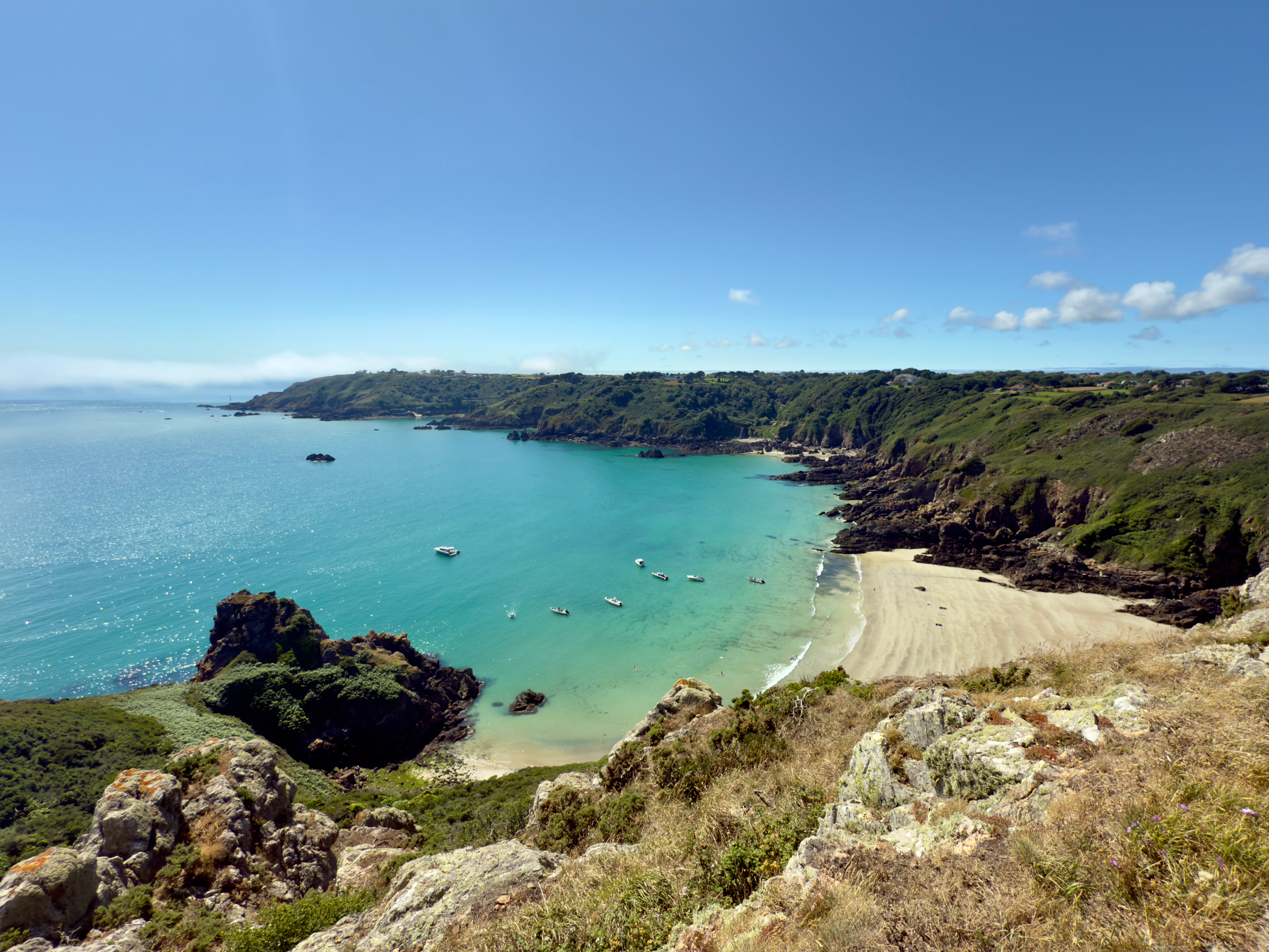 open image in galleryThis part of the Atlantic coast boasts long sandy beaches, which are perfect for both sunbathing in the summer and surfing year-round (Matt Ray / The Independent)Recommended
open image in galleryThis part of the Atlantic coast boasts long sandy beaches, which are perfect for both sunbathing in the summer and surfing year-round (Matt Ray / The Independent)Recommended 25 best self-catering cottages in the UK for countryside and beach staycations
25 best self-catering cottages in the UK for countryside and beach staycations A booming wild sauna culture is transforming how people explore the Scottish outdoors
A booming wild sauna culture is transforming how people explore the Scottish outdoors Forget Bath – this historic English town is a charming, crowd-free alternative
Forget Bath – this historic English town is a charming, crowd-free alternative
Staying on such a small island, I felt intimately connected to the sea. And because the water was so clear and clean, as if lit with underwater turquoise lights, it always looked inviting. As soon as I woke up in my room at the Peninsula Hotel, I’d feel the itch to take a dip. Fortunately, the hotel is just down the road from Rousse Battery, and its long pier, built out into the bay with large stone blocks, providing the ideal platform for a pre-breakfast swim. I took a mask and snorkel and spent an absorbing 45 minutes searching among the sunken boulders. Sea grasses waved in the current and I was overjoyed to spot the multicoloured scales of a large rainbow wrasse as I swam overhead, whose iridescent bands of purple, orange and turquoise made it look more like an escapee from a tropical aquarium than a fish in British waters.
Guernsey has a plethora of viewpoints around its coast, often aligned with defensive fortifications built in centuries past, and then bolstered by the bunker-building spree embarked upon by occupying Nazi forces in the Second World War; indeed, 2025 is the 80th anniversary of the island’s liberation. Some of the most recognisable forts are the circular and distinctively utilitarian Guernsey Loophole Towers, which were constructed between 1778 and 1799 to ward off potential invasion by the French. Of the 15 constructed, 12 still stand and with their isolated, uniform design, they look surprisingly modern. These landmarks combine with a well-signposted and maintained network of trails, some of which form the continuous Guernsey coastal path, enjoyed by walkers and trail-runners with strong knees.
Steep sections of the path around the eastern and southern coast offer access to some secluded beaches that you could only get to otherwise by boat. Later on, as I hiked atop these same high, rugged cliffs I was halted in my tracks as wisps of mist were blown away and the sea a hundred metres below suddenly burned a Caribbean blue as it gently lapped at a blazing crescent of white sand.
Read more: These islands look like Barbados – but they’re in the UK
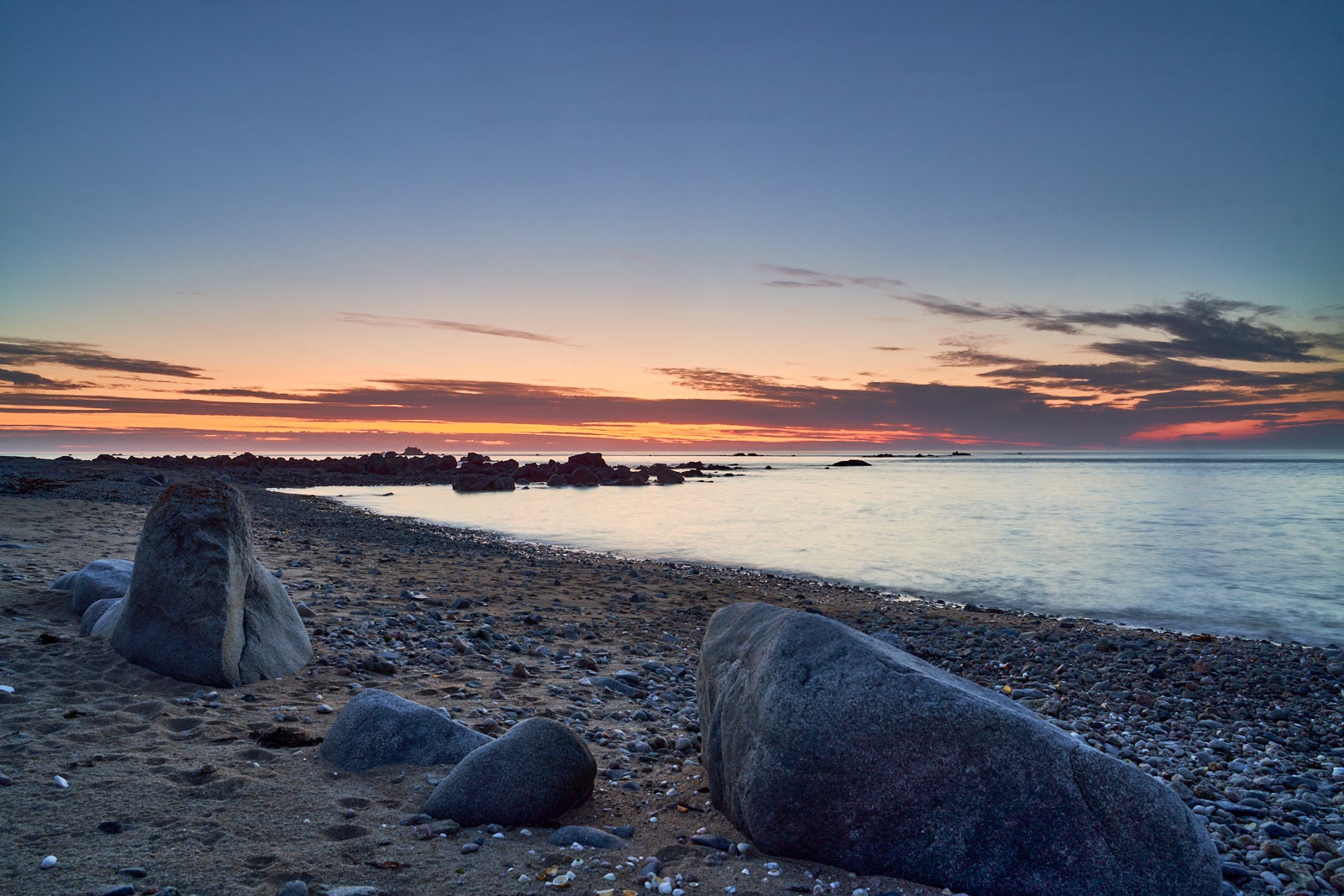 open image in galleryEnd of the day in Guernsey with the sun setting behind the shore (Matt Ray / The Independent)
open image in galleryEnd of the day in Guernsey with the sun setting behind the shore (Matt Ray / The Independent)No wonder Pierre-Auguste Renoir produced some of his greatest works here, on a summer holiday in 1883. This is celebrated by the Renoir Walk in Moulin Huet Valley, which follows the painter’s footsteps and features five empty picture frames. These are placed in the exact locations Renoir composed his works, and allow you to line up the views he painted, of Moulin Huet Bay and the craggy Pea Stacks, within the frames. It’s a nice idea but most people I saw on this trail just popped their faces into them for a seaside selfie and a more 21st-century artistic composition.
It was early evening when I met Nick Hall, the contagiously enthusiastic surf instructor and manager of Guernsey Surf School, which operates in Vazon Bay. The surf shack is overlooked by one of the 18th-century isolated towers, which I spotted from a distance. After donning my wetsuit (the water isn’t too cold but you do need a suit to surf) I headed out into the Atlantic swell. The waves were in the 2ft range, very clean, and the wave interval made them relatively easy to catch.
There’s a surprisingly well established surf culture in Guernsey, and this beach break is known as the best on the island, particularly for learning. There are no rocks, the locals are friendly and the line-up doesn’t get too crowded. As Nick explained, many of the surfers here are beginners or improvers, working hard on the basics and enjoying the benign conditions of a very approachable beach break.
 open image in galleryPaddleboarding allowed Matt to explore hidden coves (Matt Ray / The Independent)
open image in galleryPaddleboarding allowed Matt to explore hidden coves (Matt Ray / The Independent)Read more: The best lesser-known European beach destinations
A quick paddle “out back” beyond the breaking waves allowed me a moment to sit on my surfboard and soak in the view. The gentle arc of the bay sheltered the white sands of the beach, guarded by the outstretched arm of the headland, and tipped by Fort Hommet to the east.
The scene was unlike anything I’d seen before on a surfing beach; a mixture of white tropical sands, centuries-old fortresses nestled amid hedgerows, crystal-clear seawater and Atlantic breakers sent in directly from the open ocean. I popped up onto my feet and rode right on a long, flowing line of green, chased by white surf, almost all the way to the beach. My smile widened until I let out an involuntary whoop of pure joy.
Later, with sea salt in my hair, I enjoyed a proper pint of Rocquette, the crisply dry, sparkling local cider at the Rockmount pub as I watched the last pink glimmers of the sun sink into the sea. That first sip briefly transported me back to a family roadtrip through Normandy’s gîtes and ripening apple orchards, and reflected that Guernsey is an island that delivers an intoxicating blend of the familiar and the exotic.
.jpg) open image in galleryCoasteering offers a unique viewpoint of the island (Matt Ray / The Independent)Recommended
open image in galleryCoasteering offers a unique viewpoint of the island (Matt Ray / The Independent)Recommended Is this hotel the best place to stay along the north Cornish coast?
Is this hotel the best place to stay along the north Cornish coast? Tired of Airbnb? Here are the best alternatives, from boutique stays to glamping
Tired of Airbnb? Here are the best alternatives, from boutique stays to glamping 15 best pubs with rooms in the UK for cosy winter breaks
15 best pubs with rooms in the UK for cosy winter breaks
The next morning I headed to the rocky beauty spot of Petit Bot beach with local guide Antony Ford Parker, founder of Outdoor Guernsey, which runs paddleboarding, sea kayaking, coasteering and caving tours on the island.
On paddleboards we headed out of sight of Petit Bot beach, around the red rocks of the headland, and into Portelet Bay. Antony gleefully regaled me with accounts of discovering lost “smugglers’ caves” within the cliffs, which are only accessible on certain tides. Guernsey’s tidal range is one of the world’s highest, at 10 metres.
Further along the coast, we came to a huge crevasse in the rock called Les Sommelieus Cave. Paddling into it, I experienced the swell lifting me up like a giant’s palm as surf boomed out of sight, deep inside the cliff like Neptune’s grumbling snore.
Later, at La Moye, Antony pointed at a small, insignificant looking crease in the cliffs: “If you swim through there, you come into this massive cave that’s totally hidden. No one knew it was there until one of our guides, Solita, decided to swim in and discovered it a few years ago.”
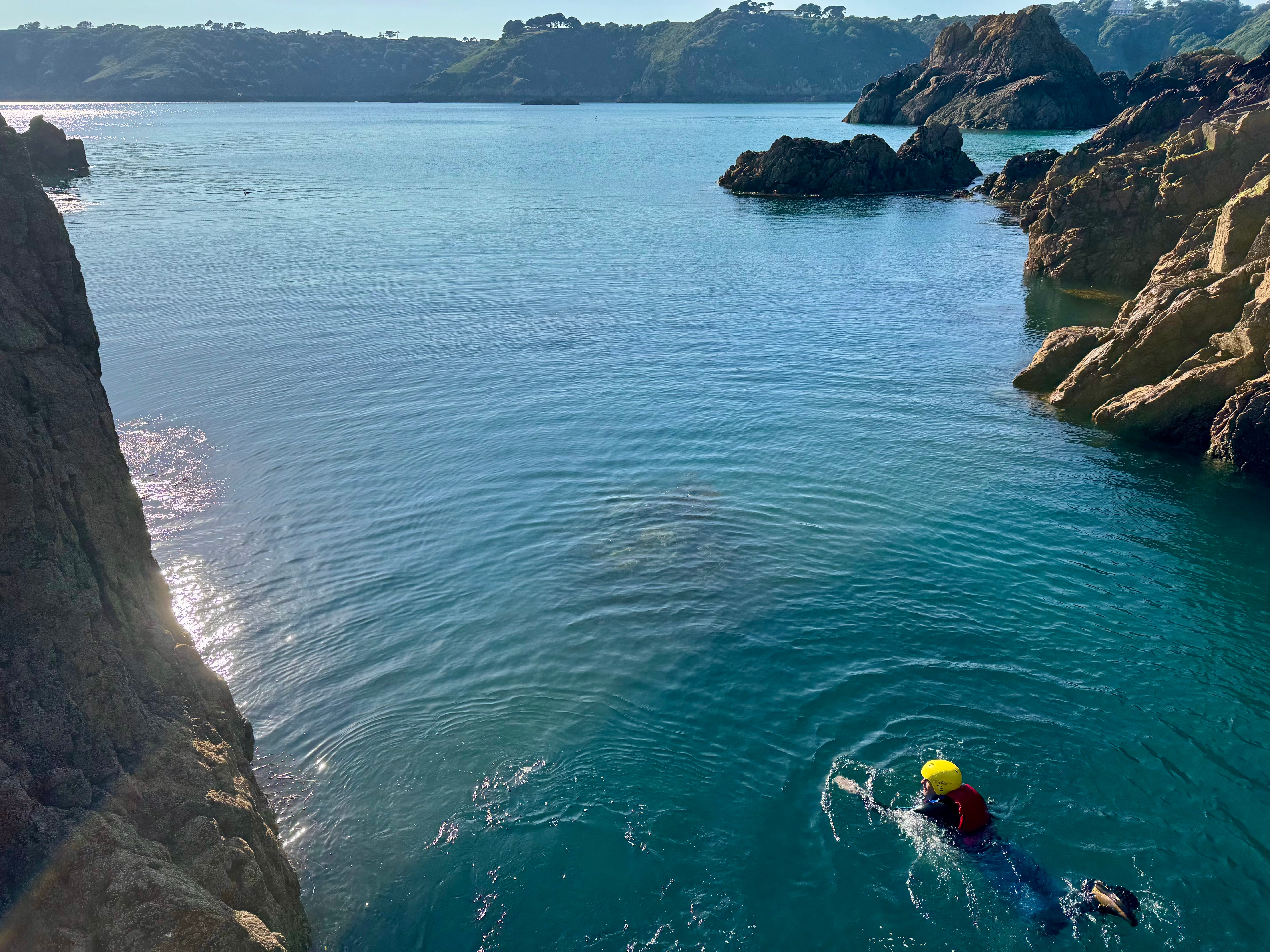 open image in galleryCoasteering involves climbing, scrambling, jumping and swimming around the coastline (Matt Ray / The Independent)
open image in galleryCoasteering involves climbing, scrambling, jumping and swimming around the coastline (Matt Ray / The Independent)One of the most famous landmarks in Guernsey, the Pea Stacks, is a series of rock towers sticking out into the sea. At the right tide, you can adventure down into a maze of colossal, pressure-transformed granite platforms, pools and chasms. This is how I found myself once again wetsuited up, this time with a helmet and buoyancy aid to experience coasteering with Alfie from Outdoor Guernsey.
I was led through a wondrous world of seaweed-cloaked boulders, squeezing between slabs of rough pink stone and nerve-racking leaps off high boulders into deep rock pools, thick with swaying kelp. Coasteering was a way to explore these otherwise impenetrable towers of stone that really brought the titanic proportions of this adventure island to life.
By the time I clambered out of that amphibious environment, and up the cliffs to rejoin the coastal path, I felt like a changed person, as if I’d connected on a primal level with the landscape, and myself. I was able to appreciate this beautifully rugged coastline in a completely different way.
Even as I struggled to get out of my wetsuit in the car park, I almost felt sorry for the tourists huddled at the top of the cliffs around Jerbourg Point, bearing witness to the glorious panorama but on some fundamental level never able to fully reach out and touch it.
Read more: Want the Lake District all to yourself? Walk the Cumbria Way
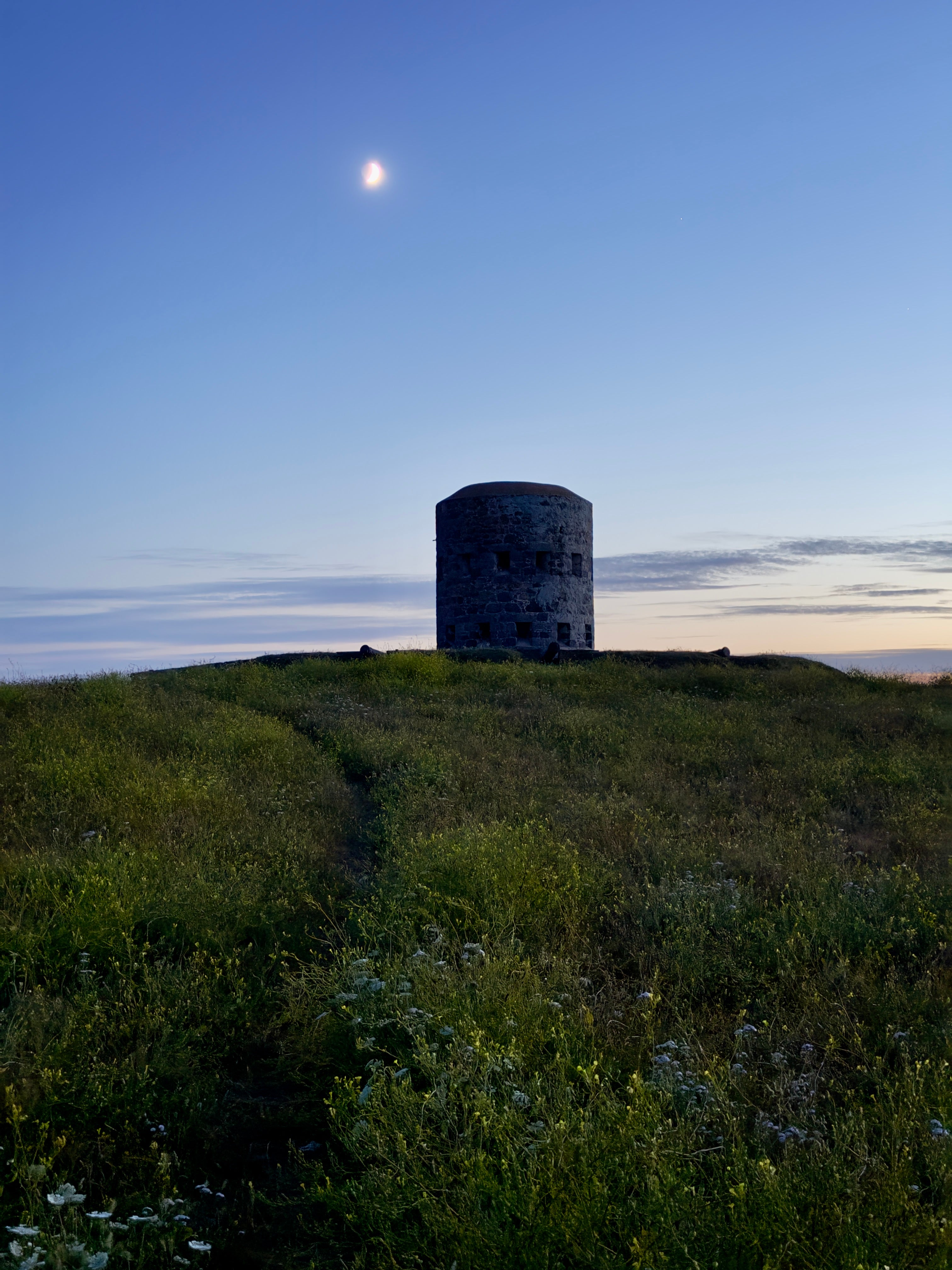 open image in galleryLast light in Guernsey (Matt Ray / The Independent)
open image in galleryLast light in Guernsey (Matt Ray / The Independent)How to get there
I flew out from London City airport on Guernsey’s own airline, Aurigny, which also flies direct from London Gatwick and regional airports. Brittany Ferries runs a high-speed car ferry from Poole and Portsmouth, which takes three hours.
Getting around
Guernsey is a small island, easily explored by hire car, although you can also get around on an e-bike (or regular bike) from Go Guernsey.
Where to eat
There’s no shortage of seaside dining options on Guernsey. A popular pub diner is the Puffin and Oyster, where I had an amazingly satisfying beer-battered haddock and chips. For the buzz of a city restaurant, visit The Slaughterhouse in Guernsey’s capital, St Peter Port. Here you’ll find top-quality steaks and grilled seafood, which can be enjoyed on the raised terrace overlooking Havelet Bay. And the interior of the island is no slouch – I had a fabulous lunch of locally-caught, pan-fried sea bass and steamed green vegetables at the rustic former 18th-century manor house, Les Douvres. For lighter, post-surfing bites and burgers, Vistas Cafe is perfectly positioned overlooking the surf spot of Vazon Bay.
Where to stay
The Peninsula Hotel
This seaside hotel has large, comfortable suites and views of traditional fishing boats bobbing at anchor in Grand Havre Bay. It’s conveniently located to access the wide-open south coast beaches, with a private outdoor pool to enjoy a dip and a cold sundowner.
The Carlton Inn
A good budget option is the two-star Carlton Inn with en-suite rooms in the country lanes of St Martin, which also houses the Wicked Wolf pub that serves food from 5.30pm.
Book now
Matt was hosted on his trip by Visit Guernsey and partners.
Read more: Secret UK beaches to visit for peace and quiet
More about
Channel IslandsSurfingBeachesJoin our commenting forum
Join thought-provoking conversations, follow other Independent readers and see their replies
Comments


